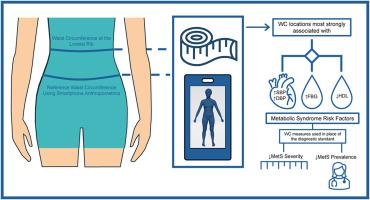Differences in metabolic syndrome severity and prevalence across nine waist circumference measurements collected from smartphone digital anthropometrics
IF 2.9
Q3 NUTRITION & DIETETICS
引用次数: 0
Abstract
Background & aims
Given the technological advances in 3D smartphone (SP) anthropometry, this technique presents a unique opportunity to improve metabolic syndrome (MetS) screening through optimal waist circumference (WC) landmarking procedures. Thus, the purpose of this study was to evaluate the associations between individual MetS risk factors and nine independent WC sites collected using tape measurement or SP anthropometrics and to determine the differences in MetS severity and prevalence when using these different WC measurement locations.
Methods
A total of 130 participants (F:74, M:56; age: 27.8 ± 11.1) completed this cross-sectional evaluation. Using traditional tape measurement, WC was measured at the lowest rib (WCRib), superior iliac crest (WCIliac), and between the WCRib and WCIliac (WCMid). Additionally, WC measurements were automated using a SP application at six sites along the torso. MetS risk factors were used to calculate MetS severity (MetSindex) and prevalence. Associations were evaluated using multiple linear regression, the effect of each WC site on MetSindex was analyzed using mixed-models ANCOVA, and differences in MetS prevalence using WCIliac as the current standard were determined using sensitivity, specificity, chi-squared tests, and odds ratios.
Results
The reference SP-WC (SPRef) and WCRib demonstrated the largest associations (all p < 0.001) with HDL cholesterol (SPRef: −0.48; WCRib: −0.49), systolic (SPRef: 0.32; WCRib: 0.30) and diastolic blood pressure (SPRef: 0.34; WCRib: 0.32), and fasting blood glucose (SPRef: 0.38; WCRib: 0.37). SPRef and WCRib were the only WC without significantly different MetSindex; yet demonstrated lower MetSindex and sensitivity (SPRef: 77.8 %; WCRib: 74.1 %) relative to WCIliac, the conventional (or standard) WC measure.
Conclusions
Compared to the current standard, SPRef and WCRib protocols are more highly associated with individual MetS risk factors and produce different MetSindex and diagnoses; highlighting the need for new MetS WC protocols. Given the surge in remote/mobile healthcare, SPRef may be an alternative to traditional methods in this context but requires further investigation before implementation.

通过智能手机数字人体测量仪收集的九种腰围测量值在代谢综合征严重程度和患病率方面的差异。
背景与目的:鉴于三维智能手机(SP)人体测量技术的进步,该技术为通过最佳腰围(WC)标记程序改善代谢综合征(MetS)筛查提供了一个独特的机会。因此,本研究旨在评估个体 MetS 风险因素与使用胶带测量或 SP 人体测量法收集的九个独立腰围测量点之间的关联,并确定使用这些不同腰围测量点时 MetS 严重程度和患病率的差异:共有 130 名参与者(女:74,男:56;年龄:27.8±11.1)完成了这项横断面评估。采用传统的卷尺测量方法,在最低肋骨处(WCRib)、髂嵴处(WCIliac)以及 WCRib 和 WCIliac 之间(WCMid)测量 WC。此外,还使用 SP 应用程序自动测量了躯干六个部位的体重。MetS 风险因素用于计算 MetS 严重程度(MetSindex)和患病率。使用多元线性回归评估相关性,使用混合模型方差分析各 WC 站点对 MetSindex 的影响,并使用灵敏度、特异性、Chi-squared 和几率来确定使用 WCIliac 作为当前标准的 MetS 患病率的差异:参考 SP-WC(SPRef)和 WCRib 与高密度脂蛋白胆固醇(SPRef:-0.48;WCRib:-0.49)、收缩压(SPRef:0.32;WCRib:0.30)和舒张压(SPRef:0.34;WCRib:0.32)以及空腹血糖(SPRef:0.38;WCRib:0.37)的相关性最大(均 p <0.001)。SPRef 和 WCRib 是唯一没有明显 MetSindex 差异的 WC;但与传统(或标准)WCIliac 相比,SPRef 的 MetSindex 和灵敏度较低(SPRef:77.8%;WCRib:74.1%):结论:与现行标准相比,SPRef 和 WCRib 方案与个人 MetS 风险因素的关联度更高,产生的 MetS 指数和诊断结果也不同;这说明需要制定新的 MetS WC 方案。鉴于远程/移动医疗保健的激增,在这种情况下,SPRef 可能是传统方法的替代方法,但在实施前需要进一步调查。
本文章由计算机程序翻译,如有差异,请以英文原文为准。
求助全文
约1分钟内获得全文
求助全文
来源期刊

Clinical nutrition ESPEN
NUTRITION & DIETETICS-
CiteScore
4.90
自引率
3.30%
发文量
512
期刊介绍:
Clinical Nutrition ESPEN is an electronic-only journal and is an official publication of the European Society for Clinical Nutrition and Metabolism (ESPEN). Nutrition and nutritional care have gained wide clinical and scientific interest during the past decades. The increasing knowledge of metabolic disturbances and nutritional assessment in chronic and acute diseases has stimulated rapid advances in design, development and clinical application of nutritional support. The aims of ESPEN are to encourage the rapid diffusion of knowledge and its application in the field of clinical nutrition and metabolism. Published bimonthly, Clinical Nutrition ESPEN focuses on publishing articles on the relationship between nutrition and disease in the setting of basic science and clinical practice. Clinical Nutrition ESPEN is available to all members of ESPEN and to all subscribers of Clinical Nutrition.
 求助内容:
求助内容: 应助结果提醒方式:
应助结果提醒方式:


